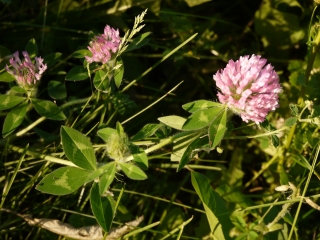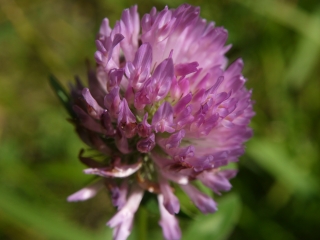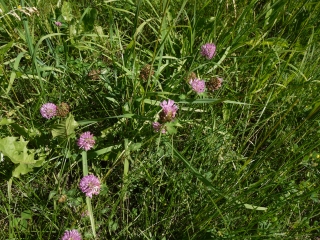home |
avr microcontroller & DIY electronics |
toolbox |
science club |
tuxtalk |
photos |
e-cards |
Online-Shop

no preservatives added blog |
computer and graphics corner |
herbal treasure chest |
splash into math |
stardust |
periodic table
red clover (trifolium pratense)

how to grow:
Red clover can easily be grown from seeds. Just throw them on the soil and they will grow. Red clover is a perennial that is hardy in zones 3-8. Bees and cows love it.
medicinal properties:
Internally and externally a red clover infusion can be used to help with all kind of skin problems. It is good for cleansing the blood. For treating skin problems you can combine it with yellow dock and nettle.
A tea or infusion of red clover is also used for treating cold and other respiratory infections like bronchitis.
It is also said to help with menopausal problems like hot flashes.

Externally the tea can also be used to treat ear and eye infections.
Red clover (as a decoction) is also said to help with many other illnesses, including malaria, whooping cough, tuberculosis, jaundice, kidney problems, inflammation of the bladder and hormone dependent cancers like breast cancer. It is said to slow cancerous growth and prevent reoccurence.
To prepare an infusion add 1-2 tablespoons (15-30g) of the (dried) flowers (and leaves (the flowers are stronger)) to 1 cup (250ml) of hot water and let it steep for 10 minutes. Drink it slowly.
To make a decoction you take 2 teaspoons (10g) of the root and let steep for 30 minutes. Remove the liquid by straining and add enough water to fill 1 cup. Take 1 tablespoon (15g) 4-5 times a day.
Red clover can also be used as a tincture.
Red clover contains many important minerals and vitamins such as vitamin C and several B vitamins, calcium, potassium, zinc, copper and magnesium among others.

cautions and possible side effects:
- Red clover has blood thinning properties. Don't use it if you are taking heart medication or have any condition where blood thinning could be a problem.
- Because of the blood thinning effect don't use 2 weeks before and after surgery.
- Don't harvest flowers that have turned brown.
- Avoid red clover when pregnant or breastfeeding.
- There have been miscarriages among pregnant animals that grazed heavily on red clover.
- Red clover has also reduced milk production and caused diarrhea in cattle.
further reading:
- The Green Pharmacy Herbal Handbook: Your Comprehensive Reference to the Best Herbs for Healing Paperback by James A. Duke, (Rodale Books (Nov. 18 2000), ISBN-13: 978-1579541842)
- A Russian Herbal: Traditional Remedies for Health and Healing by Igor Vilevich Zevin, (Healing Arts Press (1997),ISBN-13: 978-0892815494)
- herbal medicine - trends and traditions by Charles W. Kane, (Lincoln Town Pr; 1 edition (May 1 2009), ISBN-13: 978-0977133321)
- The Herbal Handbook: A User's Guide to Medical Herbalism by David Hoffmann, (Healing Arts Press; 3rd Edition, Revised Edition of The Herb User's Guide edition (Feb. 1 1998), ISBN-13: 978-0892817825)
- Rosemary Gladstar's Medicinal Herbs: A Beginner's Guide: 33 Healing Herbs to Know, Grow, and Use by Rosemary Gladstar, ( Storey Publishing, LLC (April 10 2012),ISBN-13: 978-1612120058)
- 20,000 Secrets of Tea: The Most Effective Ways to Benefit from Nature's Healing Herbs by Victoria Zak, (Bantam Doubleday Dell Publishing Group Inc (Dec 1 1999), ISBN-13: 978-0440235293)
- The Way of Herbs by Michael Tierra, ( Gallery Books (1998), ISBN-13: 978-0671023270)
Copyright © 2004-2025 Katja Socher, tuxgraphics.org




